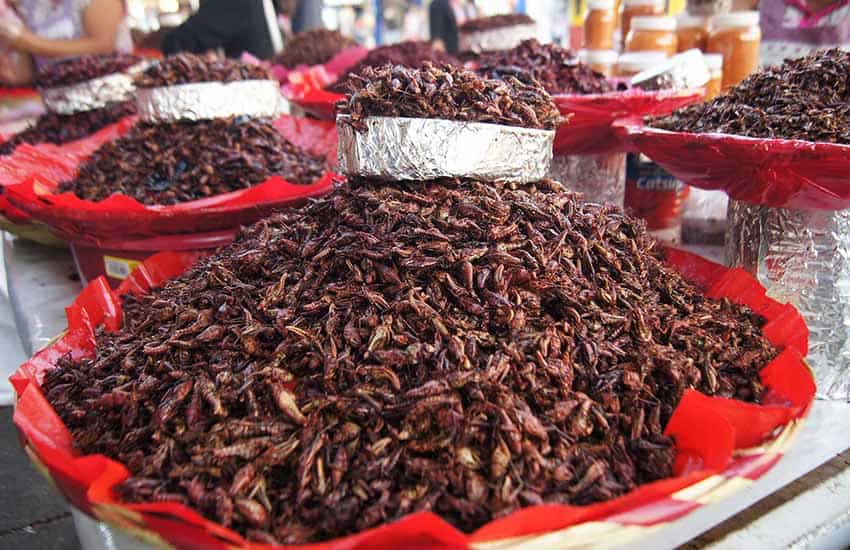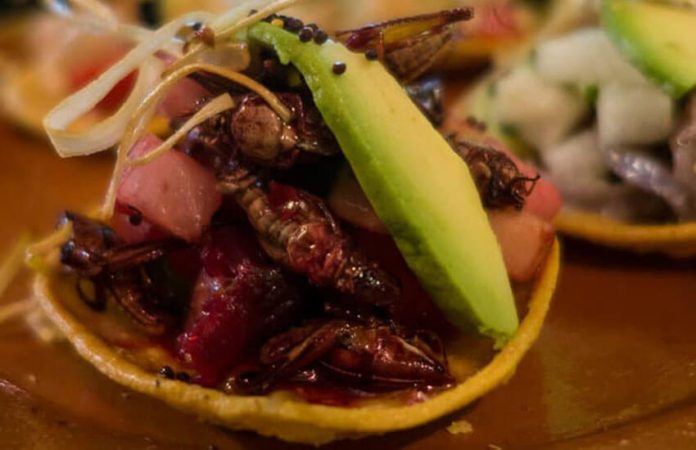The small bowl of chapulines, legs and bodies akimbo, arrived unannounced with an order of guacamole recently.
Although I know grasshoppers have been eaten in Mexico for centuries, still, so much ran through my mind, first and foremost being: do I really have to eat one?
My adventurous friend had no qualms about adding a couple to her guacamole-laden chip, declaring that they tasted like “crispy salty raisins with legs.” Alas, I couldn’t get past the gag reflex enough to chew their plump little bodies and verify that comparison. The best I could do was quickly swallow it whole, grimacing all the while.
That’s a common response to entomophagy (eating bugs) for many of us in cultures where insects are not part of our regular diet. But history tells us that not only grasshoppers but crickets, mealworms and other bugs have long been eaten in cultures around the world — and more than just the worm in the tequila bottle.
High in protein, low (or free) in cost, plentiful, local and, to some, delicious, insects are eaten in countries such as Thailand, Indonesia, Australia and, yes, Mexico. In more modern times, chapulines were served as a “novelty snack” at the Seattle Mariners home games beginning in 2017.

Chapulines are an integral part of Oaxacan cuisine, and if you’ve been there, that should come as no surprise. Fried and salted, mixed with garlic cloves and sometimes peanuts, they’re a popular snack. They’re added to tacos and tlayudas; blended into soups and guacamole; toasted on a comal; or seasoned with lime juice, chiles and salt and added to egg dishes. Blended or ground and mixed with salt, they’re turned into a pretty, reddish-brown seasoning to sprinkle on just about anything you want.
Chapulines are also popular in some parts of Mexico City. Of late, they’ve become part of a surge in interest of traditional Mexican cuisine and ingredients.
Can you eat just any grasshopper? Well, yes and no. It’s the small chapulín de la milpa that’s eaten in Oaxaca, and like many other ingredients used for cooking, young ones do indeed taste better. Harvest season starts with their hatching in May and goes through late summer. This variety is small and bright green.
While you can catch your own in other parts of the world, naturalists caution against eating any unknown bug, especially if they have bright yellow, orange or red markings, which can indicate toxicity. You’d also want to avoid areas where pesticides have been used. You can order them from Amazon.com. If you’re in Mexico, they’re available in small packages like any other spice or sometimes in bulk.
Those of you with queasy tummies may want to stop reading now. There are some tricks of the trade when it comes to preparing grasshoppers for cooking.
Even though they add so much to the presentation, you may want to remove the legs and wings; while not harmful to eat, they can be, umm, distracting. WikiHow.com has an entire page devoted to grasshoppers as food and suggests boiling them (like lobsters — alive) for a few minutes or freezing them for 10–15 minutes “to make the legs easier to pop off” and kill them.
In case you were wondering, eating raw grasshoppers is not recommended.
“Some people also pull the head straight off, which removes the guts, including the stomach. This tends to remove certain kinds of parasites,” WikiHow continues. “You can then insert a stick into the cavity and cook it over a fire. Great brushed with teriyaki sauce while roasting!”
My guess is that not many of you will venture out into a field and catch your own. Yes, one grasshopper contains a whopping six grams of protein, but still.
Should you want to experiment with your bug-cooking or insect-eating proclivities at home, try any of these recipes below — and let me know how it goes.
Garlic Butter Fried Grasshoppers
- ¼ cup butter
- 6 cloves garlic
- 1 cup grasshoppers

Melt butter in a frying pan over medium heat. Sauté garlic 4-5 minutes until golden brown; add grasshopper. Turn heat to medium-high and sauté more, stirring, about 10 minutes.
Drain on paper towels.
Grasshopper Fritters
- ¾ cup flour
- 1 tsp. baking powder
- 1 tsp. salt plus more for serving
- ¾ cup milk
- 1 egg, beaten
- 1 cup dried grasshoppers
- Vegetable or coconut oil for frying
Sift flour, baking powder and 1 tsp. salt. Add milk; whisk until smooth. Add egg.
One at a time, dip grasshoppers in batter, making sure they’re completely covered.
Heat about 1 inch of oil in frying pan. Cook coated grasshoppers until golden brown and crunchy, turning to cook all sides. Drain on paper towels, sprinkle with salt and serve warm.
Cream of Grasshopper Soup
- ½ large onion, chopped
- 2 cloves garlic, minced
- 4 plum tomatoes, chopped
- 1 cup grasshoppers (fried)
- 1 potato, cubed
- 1 liter chicken or vegetable broth
- ½ cup cream
- 2 Tbsp. olive oil
- 2 cups tortilla strips
- 4 springs fresh parsley, minced
- Salt and pepper to taste
In a saucepan, heat oil over medium heat; add onion and sauté 3–4 minutes. Add grasshoppers and garlic; cook and stir one minute. Add tomato, stir and simmer for 10 minutes. Add broth; turn heat to medium-high. When boiling, add potatoes.
Reduce heat to medium and cook 8–10 minutes till potatoes soften.
Working in batches, pour or spoon soup into blender and pulse carefully until thoroughly smooth and blended. Pour back into pan and over low heat, slowly stir in the cream. Season to taste with salt and pepper. To serve, garnish each bowl with parsley and tortillas chips.
Janet Blaser is the author of the best-selling book, Why We Left: An Anthology of American Women Expats, featured on CNBC and MarketWatch. She has lived in Mexico since 2006. You can find her on Facebook.
